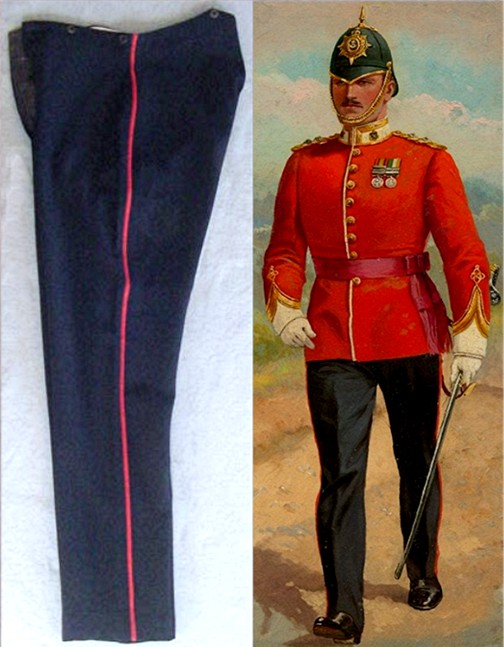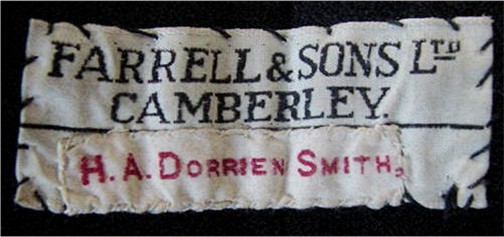|
OFFICER’S DRESS UNIFORM TROUSERS
FOR THE DUKE OF CORNWALL LIGHT INFANTRY REGIMENT –
IDENTIFIED TO A WORLD WAR TWO BRITISH PARATROOPER
LIEUTENANT HORACE ALGERNON DORRIEN-SMITH - A VERY
NICE DRESS UNIFORM ELEMENT IN EXCELLENT CONDITION WITH A
COMPELLING HISTORICAL ASSOCIATION: Oddly
enough, this pair of World War Two era Officer’s Dress
Uniform Trousers for the Duke of Cornwall Light Infantry
Regiment of the British Army, surfaced in very old
collection here in the United States. These trousers
were part of the wardrobe of Lieutenant Horace Algernon
Dorrien- Smith, made by Farrell & Sons LTD, a prolific
uniform maker in the mid-20TH Century,
located in Camberley, Surrey, England, approximately 30
miles southwest of London. As offered here, these
uniform trousers present as they must have when the
lieutenant endured the repeated fittings at the tailor,
and when he was required to wear the dress uniform of
his regiment.

That these trousers are part of an officer’s dress
uniform assigned to the Duke of Cornwall Light Infantry
Regiment was confirmed by their pattern (see the
regimental artwork) and via the lieutenant’s name
embroidered on the tailor’s maker tag. Fortunately, his
name is of such a unique format as to facilitate the
research necessary to identify him and the regiment in
which he served.

The Lieutenant was born to Major Edward Pendarves Smith
Dorrien-Smith (1878–1937) and Frances Amy Salvin Bowlby
Smith Dorrien-Smith (1890–1978) on November 30, 1919 in
Berkhamsted, Hertfordshire, England. He attended Eton,
matriculating in 1937 and then joined the Duke of
Cornwall Light Infantry Regiment, receiving his
commission.
When the British Army initially formed the airborne
force, they sought applicants from the standing
regiments with the caveat that only a maximum of four
members of any one regiment would be selected for the
airborne in order that any one standing regiment would
not be stripped of the personnel necessary to maintain
their effectiveness. The Parachute Regiment was formed
in June of 1940 as the basis of the emerging airborne
forces, and it would eventually raise and train 17
battalions during the course of the war which were drawn
on to create the 1ST and 6TH
Airborne Divisions and the 2ND Independent
Parachute Brigade Group.
Through this process, Lieutenant 95476 Horace Algernon
Dorrien-Smith
was selected for the airborne and he attended
Parachute Training Course Number 1 at RAF Ringway
November 3 – 15, 1941, and was subsequently assigned to
the 3RD Battalion of the Parachute Regiment,
Army Air Corps Service.
On April 22, 1942, while serving with A Company Lt.
Dorrien-Smith participated in a joint airborne exercise
with the 11TH Battalion, Royal Fusiliers.
The unit parachuted into New Milton and upon landing, a
Type 69 Grenade in Dorrien-Smith’s pocket detonated. He
was evacuated to Royal Victoria West Hampshire Hospital
where he succumbed to his wounds. He is buried in St
Mylor Churchyard, Mylor, Cornwall.
The lieutenant’s brother, Captain Geoffrey Richard
Dorrien-Smith served with the Buffs (Royal East Kent
Regiment), and he followed his brother into the
airborne, being assigned to the 3RD Parachute
Battalion in July 1943. He subsequently took part in
the Battle of Arnhem during Operation Market Garden
where he was killed in action on September 21, 1944. He
was buried at the Oosterbeek War Cemetery at Arnhem,
however he is also commemorated on Horace's grave stone.
The Dorrien-Smith Family paid a tremendous cost during
World War Two. In addition to the loss of Horace and
Geoffrey, their father’s brother, Major Arthur
Dorrien-Smith and his wife gave birth to four sons
(Horace’s cousins), three of whom were to perish in the
war:
- Captain Algernon Robert Augustus Dorrien-Smith
(05-05-1910 – 05-20-1940) was serving with the 15th/19th
King’s Royal Hussars, Royal Armoured Corps, BEF, when he
died of wounds received in the area of Arras, France.
He is buried in Lapugnoy Military Cemetery, Pas de
Calais, France.
- Pilot Officer Lionel Roger Dorrien-Smith RAFVR
(06-02-1918 – 05-20-1940) was serving with the 79TH
Squadron, RAF, piloting his Hurricane when he was shot
down by ground fire while attacking an enemy armored
column near St. Quentin, Aisne, Hauts de France. He has
no known grave and is commemorated on panel 8 of the
Runnymede Memorial in Bayeux Commonwealth War Graves
Commission Cemetery in France.
NOTE: These first two, Algernon
and Lionel, died on the same date, in the same area of
operations – depending on the reports – at what amounted
to approximately 45 miles apart.
- Major Francis Arthur Dorrien-Smith (08-26-21 –
06-20-44) was killed in action while serving with the 1ST
Bn, Rifle Brigade, The Prince Consort’s Own in the area
east of Caen during the Battle for Normandy. He is
buried in Bayeux Commonwealth War Graves Commission
Cemetery.
- Lieutenant-Commander Thomas Mervyn Dorrien-Smith RN
(05-12-1913 – 12-05-1973)
Of the six cousins from this line of the Dorrien-Smith
Family, only the Lt. Commander survived the war. The
five Dorrien-Smith cousins lost during World War Two are
memorialized on panels surmounting an impressive family
pew in the St. Nicholas Church located in Tresco, Isles
of Scilly, Cornwall, England.
While these trousers show obvious signs of having been
part of the lieutenant’s wardrobe, evidenced by the
presence of his name tag sewn to the tailor’s label,
they were gently worn, properly stored, and have
survived in excellent condition. The trousers present
in as close to “like new” condition as is possible,
having been worn.
There is no mothing, wear
spots, or damage of any kind. The wool
material is in overall excellent condition, is
very solid with no weak points, and there are no open
seams. There is no wear to the waist band, fly or
cuffs, all of the buttons are present, and the red
piping along the outer seams of the legs is fully intact
and retains a bright color. The white cotton pocket
body and the lining at the waist are all intact with no
evidence of wear.
How these dress uniform trousers
came to settle in a collection of American military
artifacts in New York would probably be an interesting
story in and of itself. That they survived the passage
of time, and are now reunited with the account of
Lieutenant Dorrien-Smith’s service and by extension, to
that of his brother and cousins, and the extent of the
sacrifice of the Dorrien-Smith Family, these trousers
represent a truly remarkable intersection of history. I
cannot help but believe that there is a special
collection where these trousers will be appreciated to
their fullest and displayed in the context of the
British Airborne Service and the Dorrien-Smith Family.
(0208) $300
|

